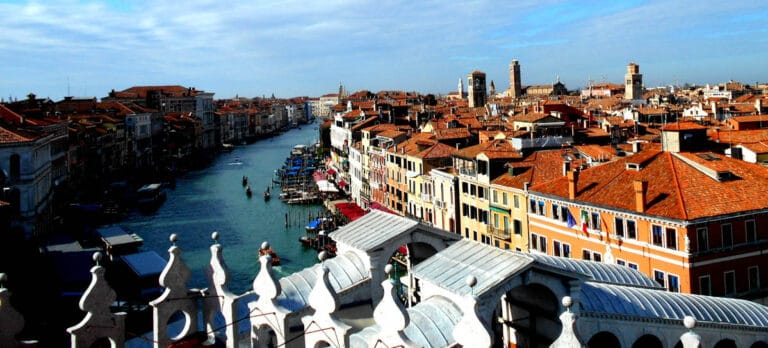
Go World Travel is reader-supported and may earn a commission from purchases made through links in this piece.
Venice brings romantic images of gondolas skimming along winding canals and pigeons cooing amongst the crowds in St. Mark’s Square. And maybe enjoying an Aperol Spritz at a sidewalk café, or boarding water taxi vaporettos.
But secret places with fascinating histories wait for you in Venice. Places that 90% of the tourists miss.
Come with me as we walk 200 meters past the Rialto Bridge to a small wooden span over a wider waterway flowing into the Grand Canal. Cross over the bridge, walk straight for 100 meters, turn left and enter the Jewish Quarter.
The Jewish Ghetto, located in the Cannaregio District, conveys a peaceful emptiness of crowds. This allows time to reflect on its 500 years of Jewish heritage.
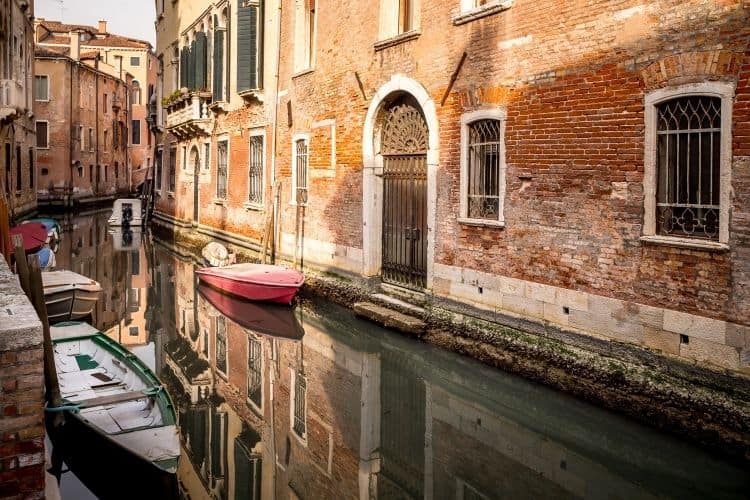
Creation of the Jewish Ghetto in Venice
As early as the 12th Century, Jewish merchants who traveled to Venice were only allowed to stay for short periods of time. But by the 16th Century, their ranks had swelled to almost 1000. The March 29, 1516, Decree of Doge Leonardo Loredam and the Senate of Venice compelled all Jews to live together in a section near San Girolamo.
They were segregated from spilling over into other parts of Venice by walls with only two gates. Closely guarded by four Christians, the gates were opened at sunrise with the ringing of St. Mark’s largest bell and locked at sunset. The Edict required the Jews to pay the guards’ salaries.

The English word ‘ghetto’ originated in this first Venetian Jewish community. It was located near a getto (pronounced jet-to), where waste was thrown from a foundry that smelted copper to make cannons.
This waste was called, getar in Italian. Unable to pronounce ‘getto,’ the German Jews used their hard ‘g’ sound and called the area ‘ghetto’. It became the universal term for segregated, Jewish communities ever since.
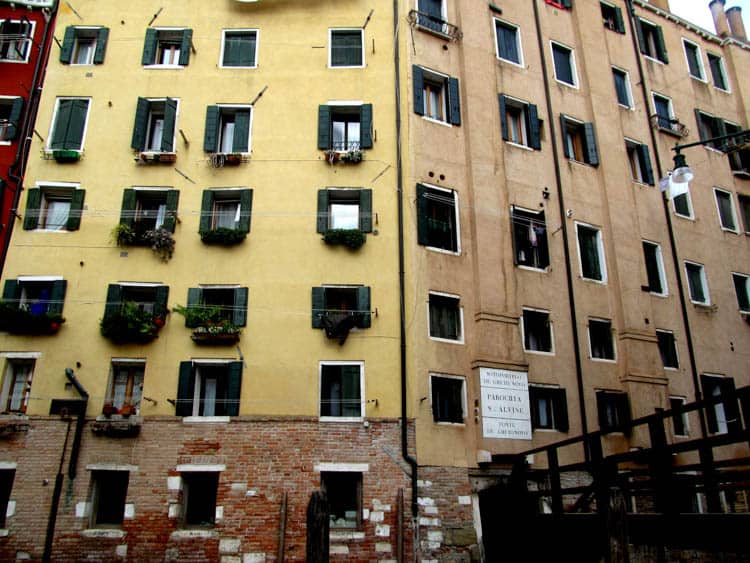
Regulations and Restrictions for the Jewish People
Early on the Jews were required to wear yellow badges and to hang a piece of lead, a symbol of shame, around their necks. Additionally, women had to wear one black shoe and one red with an attached bell.
This was so Venetians would know when a Jewish woman walked by. The interned populace could practice only three professions: money lenders, pawnbrokers and sellers of secondhand clothing.
Despite the restrictions, the confinement and the harsh conditions, the Jewish community thrived with its customs and celebrations. Five synagogues constructed within the area had to be ethnically separated as well.
Between 1528 and 1575, the German, Italian, Spanish, Portuguese and Levantine synagogues were built within existing structures. They were devoid of outside ornamentation that would distinguish them as synagogues.
Segregation Ends
On May 12, 1797, the Army of Italy, commanded by 28-year-old Napoleon Bonaparte, occupied Venice. The Venetian Republic was dissolved and the gates to the Jewish ghetto were flung open.
Subsequently, centuries of forced segregation ended. Jews remained living in this area by choice, not edict. They continue to live there practicing their traditions and customs to this day.
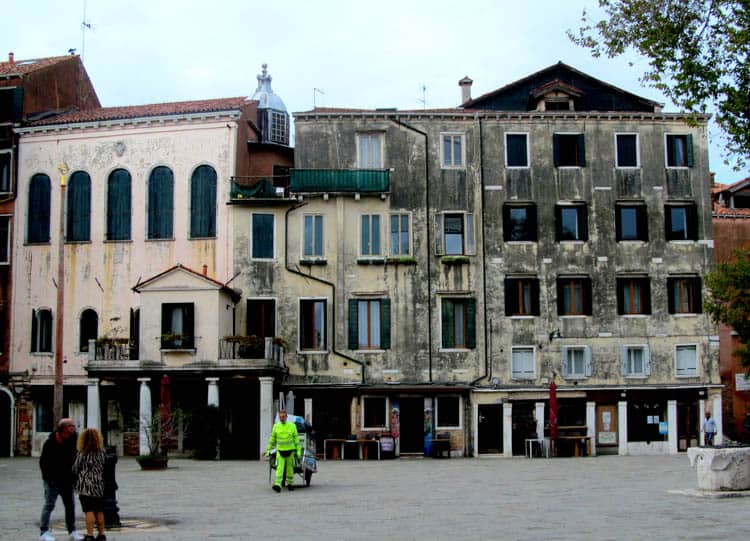
The Old and New Jewish Ghetto
As we turned the corner, street and shop signs in Hebrew confirmed that we had entered the Ghetto Nuovo (‘new’). But in contradiction, it encompasses the older ghetto. Several blocks further on the Ghetto Vecchio, which means ‘old,’ is the newer section.
We meandered through the narrow streets to reach the Campo (square) Del Ghetto Nuovo. Tall, nine-story buildings, thought to be Venetian skyscrapers, lined the square on all sides. The Jewish population had swelled to over 5000 by the 1600s.
Restricted to a limited area, the ingenious Jews added wooden partitions to lower the ceilings in order to make additional floors. This allowed them to house more people per building. Some of the units’ ceilings were lowered to the point that it was difficult to stand up straight.
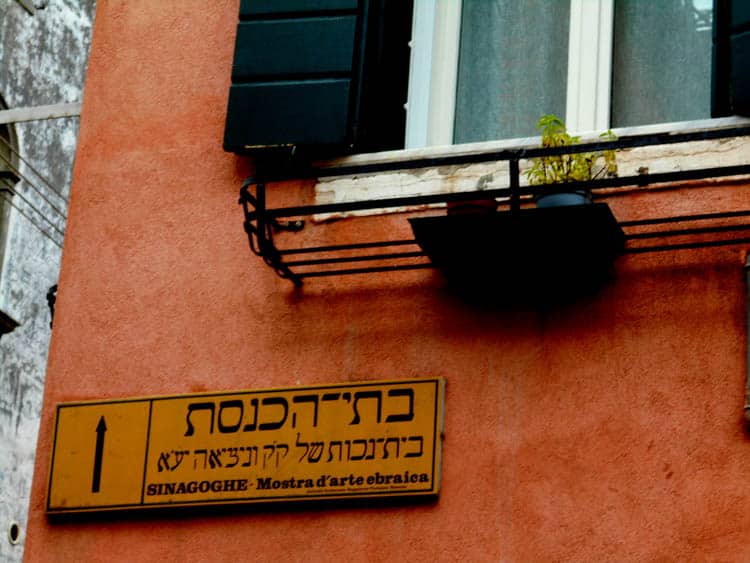
The Jewish Ghetto in Venice Today
Approximately 450 Jewish families still live in this area. The first floors of these elevated buildings now house shops reflecting daily life for Venetian Jews. There is a bakery, a bookstore, a Kosher Guest House and a restaurant. Additionally, there is a Museum of Jewish Art, Judaic shops plus two of the original synagogues.
I notice with interest a large carved, memorial plaque fastened to a building exterior. It is a monument to the Venetian Holocaust victims. In 1943, the Nazis launched a systematic hunt for Jews in Venice. Reportedly, only eight Jewish residents returned from the death camps alive.
As we left the square, we wandered the quiet, empty streets of the ghetto. Soon we happened upon the highlight of our exploration of this undiscovered historical area. Directly across from the bakery at Cannaregio 1233 in Ghetto Nuovo, we entered a world of scenes of the Jewish ghetto residents and their passion for daily life.
The walls of the shop, The Studio in Venice, danced with brightly colored images that jumped off the canvases with delight.
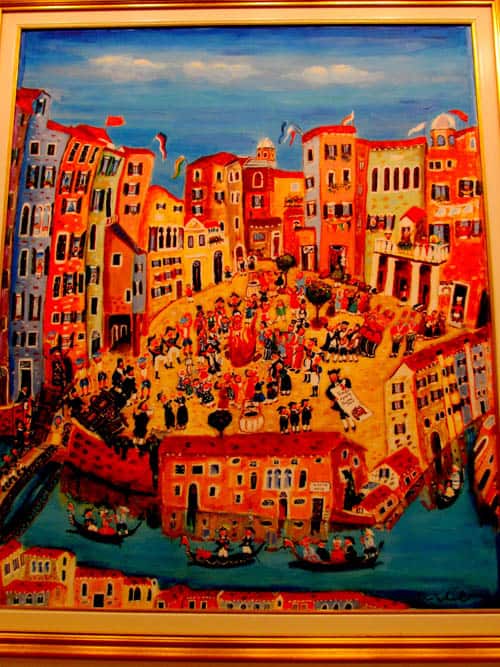
The Struggles of the Jewish Ghetto Depicted in Beautiful Illustrations
Famed, Haifa-born, Israeli artist, Michal Meron and her publisher husband, Alon Baker have captured early Jewish Ghetto experiences in an illustrated book. It is entitled 500 Years of Venetian Ghetto History and Scenes of Daily Life. Michal has completed an extensive scroll of her unique pictorial interpretation of the Torah and Jewish Festivals.
Wonderful images on canvas, ready to roll up and travel, depict the struggles in this first ghetto in Europe in 1516. The paintings show the unique environment with greater clarity than written text could ever describe.
It must be studied to appreciate the breadth of daily activities illustrated. As an example of the exceptional detail, cats, brought to Venice to solve the rat problem, dot every landscape.
Michal ranks as an acclaimed leader in the field of micrography- a Jewish form of embellishment of biblical texts and marriage contracts developed in the 9th century. I felt joy all around me and marveled at the fervor with which Michal spoke about her desire to share the Ghetto’s story with the world.
I left the shop with a deeper understanding of life in the Jewish Ghetto and how these people had the will to turn hardships into advantages. For further information, go to their websites, www.thestudioinvenice.com ; www.veniceghetto500years.com
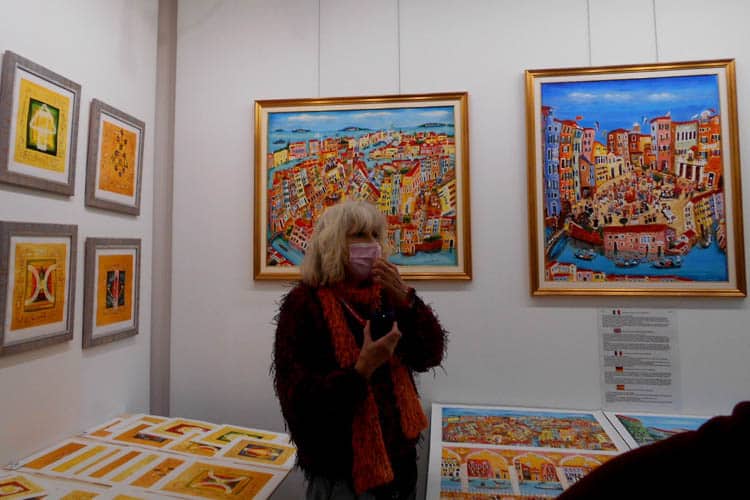
See Another Side of Venice
I have visited Venice before. I have marveled at the canals, St. Mark’s Cathedral, the Bridge of Sighs, all the tourist spots. But I have never felt the connection to the people of Venice as I did after visiting the Jewish Ghetto.
On your next trip to Venice, leave the hordes behind. Find that little wooden bridge and walk through the streets of 500 years of unique history. Then marvel at humanity rather than architecture and waterscapes.
Book This Trip
Start planning your insightful trip to Venice today. Find more information on hotels and VRBO accommodations, local restaurant reviews, insider tips on how to get around and more through TripAdvisor and Travelocity.
When you are ready to book, check out Omio Travel Partner for the best flight options, train tickets and car rentals.
Author’s Bio: After a life-long profession of treating the mentally ill at a PA psychiatric hospital for 33 years and also serving as its Director of Admissions, Carol retired to Lake Chapala, Mexico in 2006 with her husband, to pursue more positive passions. Her family thought that she, too, had ‘gone mad.’ She’s been teaching English to Mexican adults for ten years, in a program operated by volunteer expatriates and writing for local online and print publications. Using her adventures experienced during visits to over 80 countries to capture a niche in travel writing, Carol also dabbles in ‘memoir.’ A frequent contributor to Lake Chapala English magazine, “El Ojo del Lago,” she’s won several literary awards from that publication, including Best Feature in 2010 and Best Fiction in 2014. She also netted a story regarding her psychiatric field work in the published anthology, “Tales from the Couch.”
